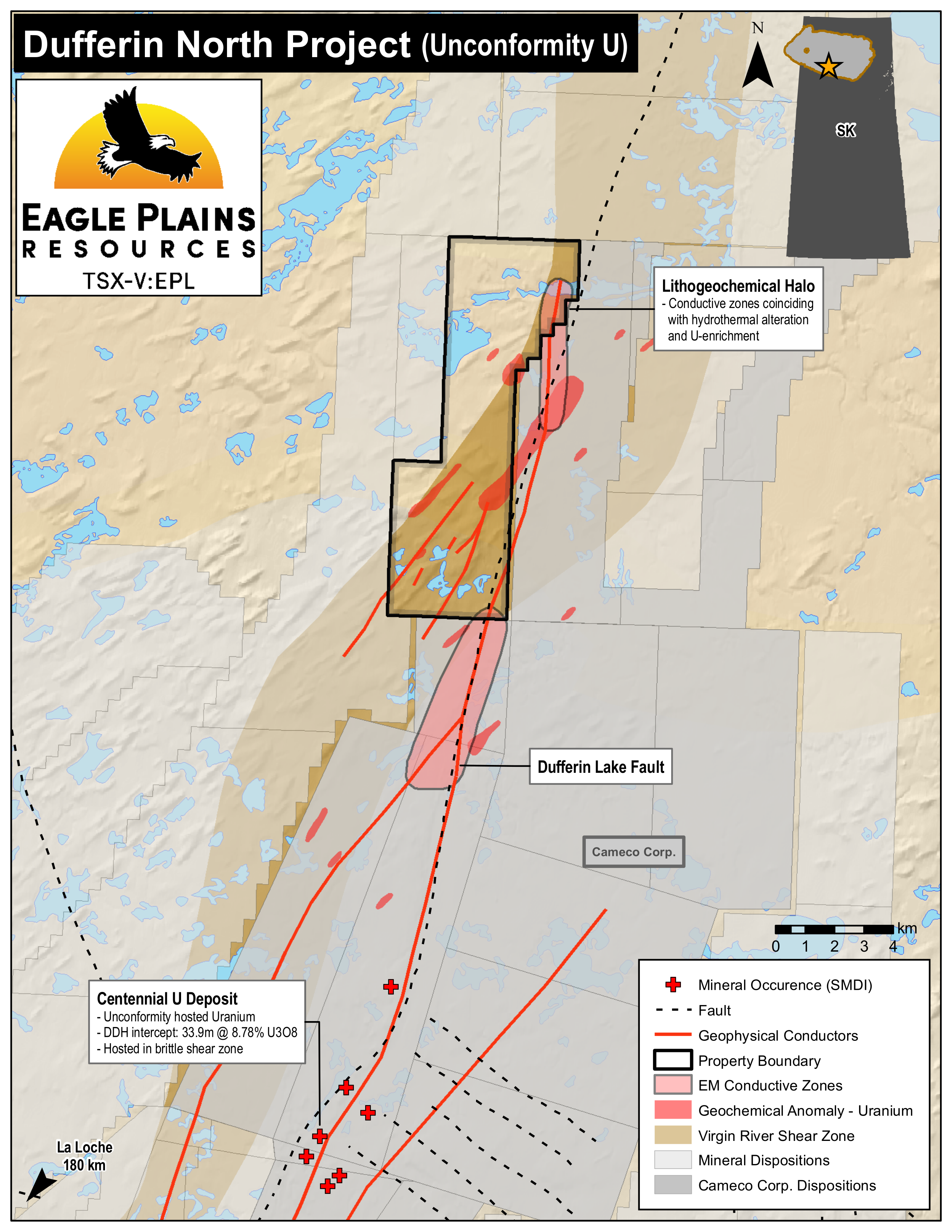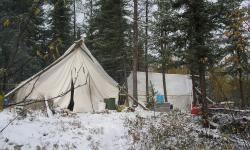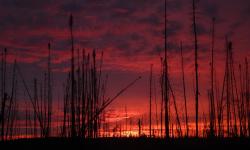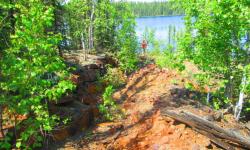
Dufferin North Project
The 4,675 ha Dufferin North Project is located in northwest Saskatchewan along the southern margin of the Athabasca Basin, 145km NE of La Loch, SK.
The property is highly prospective for unconformity- and basement-hosted uranium mineralization, similar to that seen at the world-class Centennial Uranium Zone 18 km along strike to the SW. It has seen moderate exploration since the 1960’s but remains underexplored utilizing modern exploration technologies and has never been drill tested.
-
- Saskatchewan
-
- Available for option: No
-
- Uranium
Project Highlights
- Geology that is highly prospective for unconformity and basement hosted uranium deposits
- Underexplored with limited modern exploration techniques applied
- Proven uranium district
- Centennial U deposit (Cameco Corp.) situated along strike 18 km to SSW
- Bisected by the significant Dufferin Lake Fault
Summary
The 4,675 ha Dufferin North Project is located in northwest Saskatchewan along the southern margin of the Athabasca Basin, 145km NE of La Loch, SK.
The property is highly prospective for unconformity- and basement-hosted uranium mineralization, similar to that seen at the world-class Centennial Uranium Zone 18 km along strike to the SW. It has seen moderate exploration since the 1960’s but remains underexplored utilizing modern exploration technologies and has never been drill tested.
Project Highlights
- Geology that is highly prospective for unconformity and basement hosted uranium deposits
- Underexplored with limited modern exploration techniques applied
- Proven uranium district
- Centennial U deposit (Cameco Corp.) situated along strike 18 km to SSW
- Bisected by the significant Dufferin Lake Fault
Geology
The geology of northwestern Saskatchewan comprises northeast trending belts of metamorphosed Archean-Proterozoic supracrustal and plutonic rocks of the Rae-Hearne craton overlain by siliciclastic rocks of the Proterozoic Athabasca basin.
The property overlies the Virgin River Shear Zone (VRSZ), a major structural and tectonic feature known to be a fluid pathway resulting in significant uranium mineralization which typically forms at the unconformity between granitic basement rocks and the overlying Athabasca Basin sandstones.
The NE-SW trending trace of the VRSZ and Dufferin Lake Fault transects the SE corner of the Dufferin North property, this structure is associated with the Centennial uranium zone 18 km to the SSW.
History
Uranium Exploration in the Dufferin North area began in 1978 and has continued to 2014. Exploration efforts typically focussed on geophysical and geochemical methods along the inferred position of the Dufferin Lake Fault.
Eagle Plains Exploration
Data Compilation
In late 2024 a Tier 1 data compilation was completed on the Dufferin North Project which includes consolidating, digitizing, georeferencing all publicly available historical exploration data.
Future Work
- Data compilation (Tier II) including digitizing all available exploration data and creating a digital database
- Deep-looking Airborne Geophysics to assess conductors and basement structures to target and prioritize drilling
- 3D geological and geophysical modelling assessing orientation of basement structures and position of drill targets
Eagle Plains - A Project Generator
Eagle Plains Resources is a project generator with several mineral exploration properties of merit that meet qualifying transaction requirements. We facilitate the listing process for capital pool companies and initial public offerings while providing technical expertise for exploration programs. Companies interested in co-operatively exploring any of our projects please contact: Chuck Downie at ccd@eagleplains.com or Mike Labach at mgl@eagleplains.com or call 1 866 Hunt Ore (486 8673).
The Dufferin North Project is currently not available for option
Details
The 4,675 ha Dufferin North Project is located in northwest Saskatchewan along the southern margin of the Athabasca Basin, 145km northeast of La Loch, SK. and are accessible by float-equipped fixed wing aircraft from La Ronge, SK or Fort McMurray AB.
The property is highly prospective for unconformity- and basement-hosted uranium mineralization, similar to that seen at the world-class Centennial Uranium Zone (Cameco Corp) 18 km along strike to the SW. The property has seen moderate exploration since the 1960’s but remains underexplored utilizing modern exploration technologies and has never been drill tested.
The claims were acquired in 2023-2024 through a combination of staking and a third-party purchase agreement and are owned 100% by Eagle Plains with no underlying royalties or encumbrances.
Project Highlights
- Geology that is highly prospective for unconformity and basement hosted uranium deposits
- Underexplored with limited modern exploration techniques applied
- Proven uranium district
- Centennial U deposit (Cameco Corp.) situated along strike 18 km to SSW
- Bisected by the significant Dufferin Lake Fault
Geology
The geology of northwestern Saskatchewan comprises northeast trending belts of metamorphosed Archean-Proterozoic supracrustal and plutonic rocks of the Rae-Hearne craton overlain by siliciclastic rocks of the Proterozoic Athabasca basin. Archean-Proterozoic basement rocks are strongly deformed and metamorphosed from orogenic episodes 1.9 Ga and 1.8 Ga and capped by weathered regolith formed during surficial exposure prior to Athabasca Basin formation. Sedimentation of Athabasca fluvial sandstones and conglomerates occurred from ~1750-1540 Ma, creating the 2km thick sedimentary basin preserved today.
High-grade metamorphic and granitoid rocks of the Rae and Hearne provinces were accreted together during an orogeny ~1.9 Ga and sutured along a structural corridor called the Snowbird Tectonic Zone. South of the Athabasca basin, this zone is expressed by the Virgin River Shear Zone (VRSZ). The VRSZ is a major structural and tectonic feature comprising mylonitic and cataclastic rocks dividing the Rae province on the west from the Hearne province to the east. As a major tectonic feature, this zone has also hosted post-Athabasca brittle fault reactivations and brittle faulting along lithologic contacts and fabrics.
The major unconformity between metamorphic and granitic basement rocks and the overlying Athabasca Basin sandstones is known to host some of the highest-grade uranium deposits in the world. Mineralization is thought to form along the Athabasca unconformity through the reduction of oxidized uraniferous hydrothermal fluids (through interaction with graphitic rocks) as fluids flow along reactivated basement faults (ie Dufferin Lake Fault and subparallel structures). Most discoveries in the basin are concentrated along the unconformity edge where the sedimentary cover is the thinnest, but the discovery and tracing of faults below the basin cover is driving exploration further into the basin unconformity uranium mineralization is found near faults parallel to and within the VRSZ.
The Dufferin North property is located along the southern edge of the Athabasca Basin, ~35 km from the unconformity edge. This property sits on exposures of the Lazenby Lake Formation, with an approximate stratigraphic thickness of ~1000m, which overlies granitoid gneisses and high-grade metasedimentary rocks of the Taltson domain basement rocks. The NE-SW trending trace of the VRSZ and Dufferin Lake Fault, a steeply west dipping brittle fault, transects the SE corner of the Dufferin North property. This structure is spatially associated with the Centennial Uranium Zone 18 km to the SSW, the most prominent uranium discovery in this region of the basin.
Mineralization
There are no documented SMDI mineral occurrences within the Dufferin North tenure. Several monometallic and polymetallic unconformity uranium occurrences are found along the Dufferin Lake fault and other NE-SW trending faults that transect the tenure. Sandstone- and basement-hosted uranium mineralization is predominantly found along these brittle post-Athabasca faults.
The most significant mineral occurrence in the region is the Centennial zone which hosts sandstone- and basement-hosted unconformity uranium mineralization extending ~600m along a NNE trend. Diamond drilling intersected grades up to 25.6% U3O8 over 0.5m and 8.78% U3O8 over 33.9m (SMDI 2758). A relatively high concentration of secondary U-bearing minerals indicate uranium remobilization may play an important role in this region of the Athabasca Basin. A similar deposit model should be assessed at Dufferin North.
History
Exploration in the Dufferin North area began in 1978 when Denison Mines Ltd. conducted an airborne radiometric survey, ground VLF-EM and scintillometer surveys, prospecting and mapping, and lake and stream sediment geochemical surveys identifying NE-SW trending EM conductors in the southern portion of the Dufferin North tenure. In 1979 Denison Mines Ltd. conducted additional airborne magnetic and radiometric surveys, VLF-EM survey, and geological mapping and prospecting but failed to highlight new conductors within the Dufferin North tenure.
From 1979-1980 S.E.R.U. Nucleaire Ltd. conducted airborne magnetic, radiometric, EM, and VLF-EM surveys and lake sediment geochemistry surveys in the Dufferin North area. Exploration discovered weak uranium anomalies east of the Dufferin Lake fault, similar to other uranium showings along this structure such as the Centennial Uranium zone.
In 1995-1996, Uranerz Exploration and Mining Ltd. completed TDEM geophysical surveys, geological mapping and prospecting, and outcrop and boulder geochemistry in the Dufferin North area. Exploration discovered inferred shear zones and lithogeochemical anomalies parallel to the Dufferin Lake fault including up to 400 ppm B, 0.3 ppm U, and illite-rich zones.
In 1998, Uranerz Exploration and Mining Ltd. completed eight diamond drill holes (6705.1m), south of the current property, and intersected mineralized intervals of Athabasca sandstone assaying up to 2% U over 0.2m proximal to the Dufferin Lake fault. Further exploration included an airborne GEOTEM geophysical survey, discovering NE-SW trending conductors parallel to major faults/shear zones.
In 2005, Stratholme Mineral Corporation conducted an airborne MEGATEM survey in the Dufferin North area discovering a magnetic low that spans the current tenure. The same year, Cameco Corporation completed an airborne MEGATEM survey, AMT survey, and conducted diamond drill core resampling and spectroscopy. Geophysics identified NE-SW trending conductive zones in the area hypothesized to be potential alteration zones in Athabasca strata. Drill core resampling assayed minor kaolinite and illite in the lower Athabasca Group, as well as sporadic chlorite and dravite in illitic zones.
In 2006, Cameco Corporation completed additional airborne gravity, magnetic, and radiometric surveys in the Dufferin North area. Geophysics delineated basement lithology contacts and inferred NE-SW and NW-SE trending faults below the Athabasca unconformity. Further work by 101073531 Sask Ltd. and Thunder Sword Resources Inc. included the completion of an airborne GEOTEM survey, identifying previously unrecognized NE-SW trending conductors parallel to the Dufferin Lake fault.
In 2014, Uravan Minerals Inc. completed two diamond drill holes (2785m), drill core geochemistry and gamma logs, TDEM and IFG geophysical surveys, as well as soil, boulder, and tree geochemical surveys in the Dufferin North area. Diamond drilling (approximately 6 km east of the current tenure) aimed to test a ZTEM conductor and both holes intersected desilicified zones of dravite-rich fault gouge presumed to be a splay fault from the primary conductor. Diamond drill hole SL14-002 encountered elevated radioactivity of 185 cps along the unconformity, and the alteration pattern through the hole suggests it intersected the periphery of a hydrothermal circulation cell.
Eagle Plains Exploration
Data Compilation
A comprehensive data compilation (Tier I) has been completed on the Dufferin North Project which includes identifying, reviewing and digitizing significant geological information from all publicly available historical exploration data.
Interpretation
Most exploration in the region has focused within the VRSZ and the surrounding NE-SW trending faults where occurrences of monometallic and polymetallic unconformity uranium mineralization have been discovered within reactivated brittle fault zones. Historic exploration for unconformity uranium deposits targeted EM conductors for graphitic units or shear zones, which are known to host U-mineralization along the Athabasca Basin basal unconformity.
Mineralization in the region occurs as sandstone- and basement-hosted unconformity uranium deposits localized along NE-SW trending basement faults. Athabasca-type unconformity uranium deposits are typically associated with graphitic metasediments and shear zones which yield a strong EM conductor response. At the nearby Centennial zone, uranium mineralization is found along a faulted basement contact at the edge of an unconformity high. This zone is also 200m west of a graphitic EM conductor and 300-400m east of the inferred Dufferin Lake fault. The Centennial zone is cross-cut by NW-SE trending altered diabase dykes and also contains a relatively high concentration of secondary U-bearing minerals. This indicates there was a later phase of hydrothermal alteration and uranium remobilization after the primary phase of Athabasca-type uranium mineralization of ~1590 Ma. The gap between uranium mineralization and major structural/geophysical features and evidence of uranium remobilization suggests a wider exploration approach should be employed in this region.
Target model
Exploration on the Dufferin North properties should focus on sandstone- and basement-hosted unconformity uranium mineralization. Faulted basement contacts and brittlely reactivated structures are the primary locations for mineralization. Paleo-topographic highs along the Athabasca unconformity are a first-order indicator of rheological contrast in the basement and represent ideal locations for brittle fault formation and reactivation.
Several uranium and polymetallic uranium occurrences occur along and proximal to the Dufferin Lake fault SE of the VRSZ. The inferred trace of this fault follows EM conductors and overlaps surficial geochemical anomalies on the eastern edge of Dufferin North. Structures with proven uranium mineralization are ideal targets for further exploration. Regional EM conductors are underexplored and locally coincide with regional geochemical anomalies at Dufferin North. The subsurface projection of the VRSZ through most of this tenure suggests the possibility of basement structures favourable for hydrothermal fluid flow.
Future Work
- Data compilation (Tier II) including digitizing all available exploration data and creating a digital database
- Deep-looking Airborne Geophysics to assess conductors and basement structures to target and prioritize drilling
- 3D geological and geophysical modelling assessing orientation of basement structures and position of drill targets
Eagle Plains - A Project Generator
Eagle Plains Resources is a project generator with several mineral exploration properties of merit that meet qualifying transaction requirements. We facilitate the listing process for capital pool companies and initial public offerings while providing technical expertise for exploration programs. Companies interested in co-operatively exploring any of our projects please contact: Chuck Downie at ccd@eagleplains.com or Mike Labach at mgl@eagleplains.com or call 1 866 Hunt Ore (486 8673).
Updated October 22, 2024




